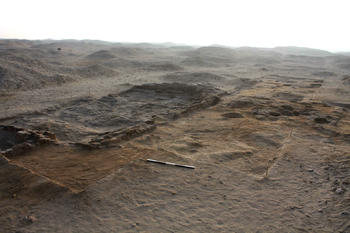Working in the Suburbs: the study of archaeological and material remains at domestic workshop site M50.14-16 at Amarna
Ägyptologisches Seminar
DFG
Blick (Richtung Nordost) über das 2014 ausgegrabene Areal: der südliche Teil des Hauses M50.16 liegt auf der linken Bildhälfte, während der Hof M50.14 rechts zu sehen ist
Image Credit: Anna Hodgkinson.
This project will document and contextualize the archaeological site known as M50.14-16, a domestic workshop in the Main City South at Tell el-Amarna (Amarna: ancient Akhetaten in Middle Egypt, c. 1353–c. 1336 BC). The site is a unique example of an urban domestic workshop for the manufacture of vitreous materials at household level, forming a missing link in the urban network of industrial activities at Amarna. Site M50.14-16 was excavated cursorily in 1922 and remained largely undocumented, permitting only vague assumptions on its nature as a glass-processing centre. Recent work, directed by the applicant, yielded a substantial amount of detailed and well-documented archaeological data regarding the site, which encompasses a main, domestic building (M50.16) a secondary building (M50.15) and outside working areas (M50.14). In situ evidence of industrial activity was excavated, the most prominent industry being glass-working, including two glass ingots – in addition to faience manufacture, metal-working and agate processing. The findings may indicate that the site played an important role in the glass industries of Amarna, and, possibly, in the international exchange of glass during the Late Bronze Age. In order to reconstruct the historical development and role of the site, the archaeological archive will be reviewed. The study of the spatial distribution of objects through digital mapping will enable the identification of activity zones. An inter-Egyptian and interdisciplinary comparison (particularly with the Ancient Near East) of the archaeological evidence of manufacture will deliver new information on Late Bronze Age socio-economic processes in an urban environment, in particular with regard to the chaîne opératoire of craft production and its organisation. The contextualization of the site within its direct environment will facilitate the understanding of M50.14-16 as an urban domestic workshop and the activities carried out by its occupants at the site and across Amarna. The project will be carried out at Freie Universität Berlin (Ägyptologisches Seminar) and in collaboration with the Amarna Project (University of Cambridge) over a period of three years.
